The beetles and the beasts
Published · Updated
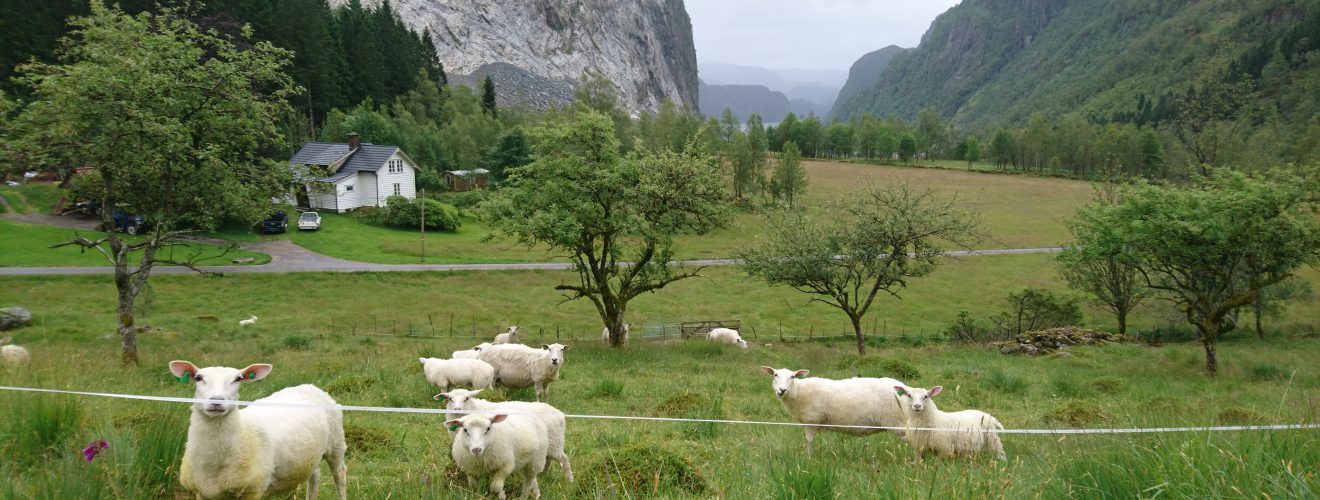
A report written by Ingrid Vaksvik
Abstract
This study explores the interactions between domestic herbivores and beetles in the fjord system of the Nordhordland Biosphere Reserve. Fields grazed by sheep had overall higher beetle abundance, even if the number of families did not vary. I also found that beetle diversity and abundance were affected by the ecological zone: coastal sites showed higher beetle abundance, particularly including hygrophilous families, compared to fjord sites. The type of livestock seems to have an influence on the composition of beetle assemblages, but it may be covered by stronger environmental effects.
Introduction
Small-scale farming and versatile land use have been practiced in Nordhordland Biosphere Reserve (NBR) for more than 6000 years (Hjelle et al., 2018). This has resulted in an assemblage of diverse landscapes, including “semi-natural” grasslands which are defined by the modification of vegetation (e.g., using domestic livestock for labour, grazing, and food) and the need for cultivation (e.g., creating artificial plant communities) (Kaland et al., 2018). Fodder production (plant biomass) for animals supports the livelihood of humans and can provide a rich habitat for insects that may serve as pollinators and/or natural pest control (Bengtsson et al., 2019). However, agricultural intensification has contributed to species extinction and lower diversity in both pollinators and European carabids, such as ground beetles. This is eligibly caused by the use of artificial pesticides, along with the removal of hedgerows and other natural habitat features (Sánchez-Bayo & Wyckhuys, 2019). In coastal Norway, changes in agricultural practices can be illustrated by the diversification of livestock and the grazing intensification at a local scale (Austrheim et al., 2011). For instance, the main sheep breed used in Norway in the last decades is heavier than other breeds and forages more on graminoids than woody species. The number of grazing sheep was in decline between 2004 and 2014, a change that may also have an indirect effect on invertebrates and grassland structure (Ross et al., 2016).
Different types of livestock have different specificities regarding fodder preference, foraging pattern, trampling, and dung dropping. It is possible that this affects the local environment differently, including soil, litter, plant, and arthropod communities (Kotze et al., 2011; Liu et al., 2015; McFerran et al., 1994; Zhu et al., 2015; Garrido et al., 2019). The assemblage of insects associated with dung, such as the paraphyletic group of “dung beetles” (Scarabaeidae), will be particularly influenced by the presence of cows (van Klink et al., 2015; Zhu et al., 2015). Species in the families of rove beetles (Staphylinidae), ground beetles (Carabidae), and scarabs (Scarabaeidae) are attracted to fresh cattle dung in both open and wooded pastures (Galante et al., 1995). Carabidae are particularly sensitive to changes by both natural and human-induced disturbance and thus were shown to be a good indicator of the health of an ecosystem (Koivula, 2011). The grazer species will however not be the only factor affecting dung beetle assemblages. Requirements for moisture, pH, light exposure, and soil type e.g., differ between families, implying that the local environment plays an important role in shaping beetle assemblage. The fjord system of the NBR offers very complex and intertwined climatic, geomorphological, and ecological conditions. The coastal areas are flat and moist, exposed to strong winds, salts from sea spray, and high precipitation. The coast also has milder winters and colder summers than the inner fjords (Hjelle et al., 2018).
A healthy ecosystem should contain species communities that are diverse and abundant. Certain beetle families (such as carabids) function as indicators of overall biodiversity and ecosystem health. They show predictable responses to both small- and large-scale variations of management and disturbance. These variations can be indicated by the presence or absence of carabids – which may also reveal the condition of certain beetle species and/or other animal taxa (Kotze et al., 2011). Ground beetles are affected by pollution such as heavy metals in soil or by pesticides, and their mean individual body mass can be linked to succession in numerous habitats (carabids being habitat-generalists) (Kotze et al., 2011). Furthermore, carabids include keystone species whose abundance may impose dramatic effects on pests and crop production - as they are responsive to both agriculture and forestry disturbance (Kotze et al., 2011). Some carabid species may even signal environmental change by e.g., shifting the altitude of habitat residence (Kotze et al., 2011). However, these responses should be addressed individually unless otherwise proven for that taxon and/or for conditions that are hard to observe. By using these indicators, we can potentially enhance conditions for carabid families and their living habitats (Kotze et al., 2011; Sánchez-Bayo & Wyckhuys, 2019).
In this study, the overall impacts of different grazers (cows, sheep, goats) are compared using the total abundance of beetles, abundance in main families of beetles, and family diversity of beetles.
By comparing different grazers across different sites of the Nordhordland Biosphere Reserve, I hope to find the effect of grazers and geographical location on beetle diversity and abundance. For each study site, I will explore the total abundance of beetle, abundance in main families of beetles, and family diversity of beetles. I seek to answer two hypotheses:
H1: More dung in cow sites will result in a generally higher abundance of dung beetles than in sites grazed by sheep and goats.
H2: Geographical location will have an impact on beetle diversity and abundance. For instance, coastal areas may get more precipitation and higher levels of salinity in the soil – which can have indirect effects on the beetles.
Material & methods
Study Area
The study area is the Nordhordland Biosphere Reserve (NBR), including nine grassland study sites (Figure 1). Three of the sites were sampled closer to the coast (O’ coding/outer fjord, Table 1), while the other six sites were in the fjords (I’ coding/coast, Table 1). All sites were grazed by either cows, sheep, or goats. Additional details are listed in Table 1. We collected the samples in systems with low-intensity grazing, and low to no pesticide usage.
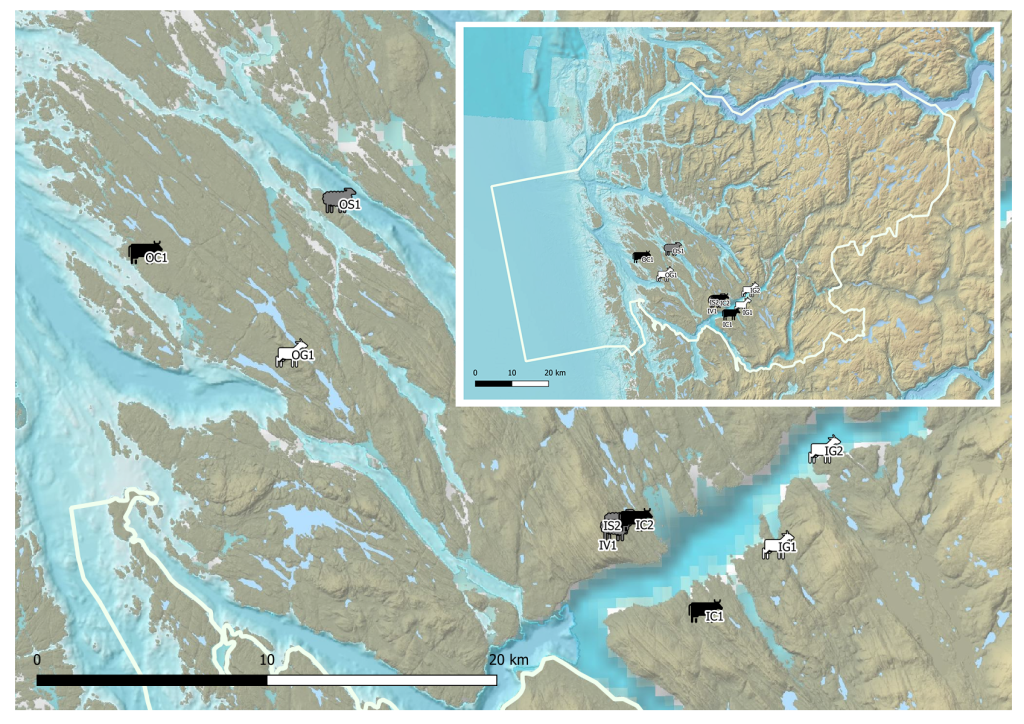
Figure 1. Location of the nine sites grazed either by sheep (grey), goat (white) or cows (black). Credits: Morgane Kerdoncuff.
Data Collection
Sites were defined as sampling areas of 20 x 20 m2, with homogeneous grassland vegetation cover representative of the surrounding grazing field area. Wet zones (e.g., with peat moss or cotton grass) or bare rock were avoided. The aspect and elevation of the sites were recorded. In each site, we installed three sets of four dung-baited pitfall traps. One set was made of a 1 m2 square, with one trap on each corner. Sets were separated from each other by a minimum distance of 6 m2. There was a total of 12 traps per site, which resulted in 108 samples for the overall survey. Each trap had a diameter of 11.5 cm and was covered by a wire mesh and baited with cow dung to attract dung beetles.
The samples in this project are from different periods during summer 2019, with traps being active for one week each (Table 1). All beetles were then sorted by family in the lab and stored in 70 % ethanol. For family identification I used Duff & Smith (2012) and Unwin (1985).
Data Handling
The survey will address the following response variables: total abundance of beetles, abundance per family and family diversity. The variables were visualized as bar plots using Microsoft Excel.
Results
My results showed that different grazers had different impacts on beetle communities. It seems that beetle abundance may not be related to beetle diversity.
The abundance of beetles per. site ranged from 69 (IG2) to 1672 (OS1) individuals (Figure 2). The sites grazed by sheep had an overall greater abundance of beetles but also showed the highest variability across sites. The lowest abundance of beetles is found in a goat site (IG2). On average I found a total abundance of beetles of 157 for sheep, 97 for goats, and 77 for cows. There is a clear difference between fjord and coastal sites, especially for sheep and goats – reflected in e.g., four times as many beetles in the OS1 site than in the IS2 site.
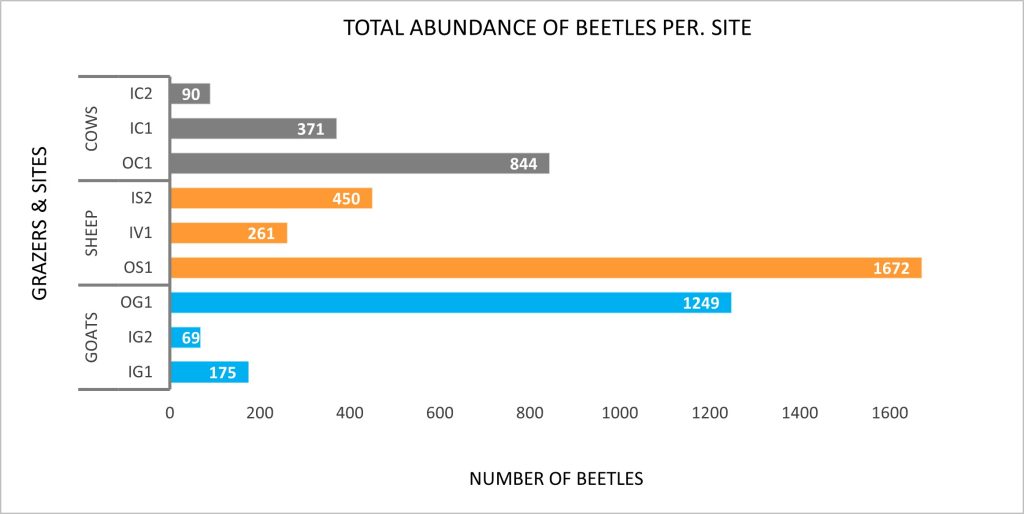
Figure 2. Total abundance of beetles for each site, classified according to livestock type (cows, sheep, goats).
The coastal sites (OC1, OS1, OG1) had an overall higher abundance of beetles, particularly for Staphylinidae (rove beetles) but also for Hydrophilidae (water scavenger beetles) (Figure 3). Staphylinids are most abundant for all sites, except the IC2 site grazed by cows. Carabidae (ground beetles) and Scarabidae (dung beetles) are the least abundant families throughout nearly all sites. The sheep sites IS2 and OS1 stood out by having the highest abundance of dung beetles. The goat sites in fjords had the lowest abundance of beetles per. family of all the fjord sites in the survey.
The total abundance of beetles is highest in sheep sites (Figure 2). These sites also have the highest abundance of beetles in different families (Figure 3). This is true for three out of the five families analysed, respectively the families of Scarabidae, Staphylinidae, and Hydrophilidae. Ptiliidae (featherwing beetles) were most abundant in OC1 (Figure 3), however, they seemed to thrive in any habitat.
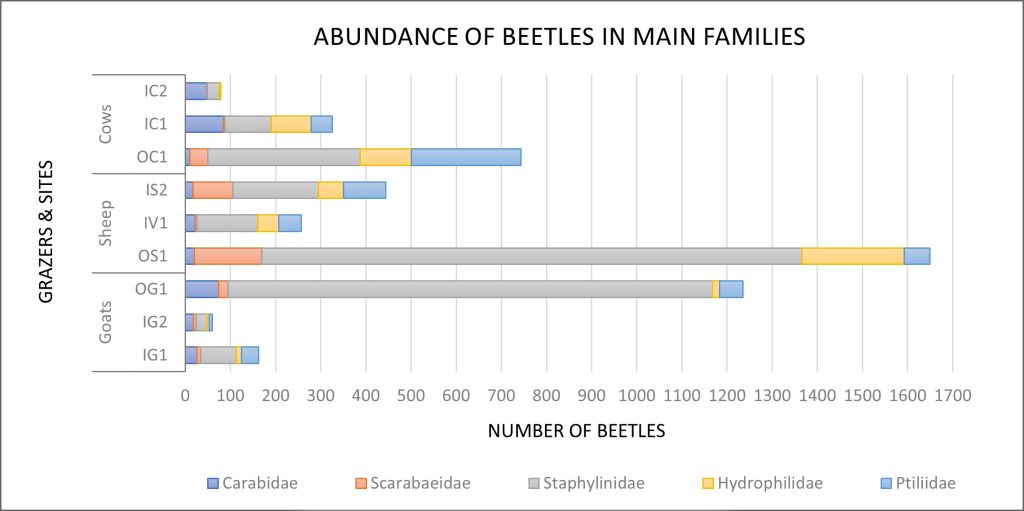
Figure 3. Total abundance of beetles for the main families (Carabidae, Scarabaeidae, Staphylinidae, Hydrophilidae and Ptiliidae) in each site, classified by livestock type.
The diversity ranges from 5.0 to 9.0 families per site. Cow and goat sites have 9.0 families in two out of three sites. The average number of families is highest in cow sites by 8.0, closely followed by goats with 7.7 and sheep sites with an average of 7.0 families per site (Figure 4).
From figure 2, 3 and 4 we can observe that beetle abundance and diversity do not always follow the same trends. For instance, beetle abundance is substantially lower on IG2 and IC1, yet the number of families identified is quite similar to other sites.
Regarding geographical location, the abundance in main families is highest in coastal sites – as with the overall abundance.
Discussion
The negative impact of intensified agriculture involves the abandonment of small-scale farming and semi-natural grassland, which has disadvantages for biodiversity. Yet, grazing in semi-natural grassland affect keystone species such as beetles of the carabid family. They are immensely affected by their environment and may respond to grazing regimes by grazer species (Sánchez-Bayo & Wyckhuys, 2019; Zhu et al., 2015; Pozsgai et al., 2022). We collected beetles from nine locations with semi-natural grassland in Nordhordland Biosphere Reserve. The abundance and diversity of beetles were then compared to the type of grazer in their habitat and habitat location. From my analysis, I could observe the following trends: the total beetle abundance in the fjords was lower than in the coastal areas, and it was higher in sites grazed by sheep. Beetle abundance and diversity were not consistently following similar trends: very low abundance was not followed by lower diversity. The first hypothesis of this study was not supported by my results, as sites grazed by cows do not obtain a higher abundance of carabids (Figure 2-3). My second hypothesis is verified, as there are some clear patterns when it comes to carabid abundance in different sites (Figure 2-3). Diversity is slightly higher in coastal sites (Figure 4), even though it doesn't appear to be related to any particular factors.
Diversity and Abundance are not always Mutually Consistent
It is important to check both diversity and abundance because more abundance does not necessarily mean that a beetle community is thriving under the specific circumstances of that area (Koivula, 2011). Although grazing has an impact on the diversity of plants, plant diversity is not shown to have a direct impact on arthropod diversity (Borer et al., 2012). On the other hand, there is support for a link between the biomass of plants and arthropod diversity. That said, arthropod abundance does not have to be affected by the increase in plant production (Borer et al., 2012). High species abundance can serve as a reflection of trees and shrubs in a heterogeneous landscape. Small-scale grazing is one such system, with a mosaic of open habitats and woodland. This vegetation may function as a foraging resource and microclimate refuge in times of environmental stress (Söderström et al., 2001). Vegetation is in turn affected by the type of grazer and grazing patterns. Sheep mainly graze on grass and occasionally woody species and forbs, goats graze on woody species and grasses while cows prefer grass but may eat forbs. These preferences lead to grassland with diversity in structure, reflecting what type of plants that are not grazed on (Mphinyane et al., 2015; Scohier & Dumont, 2012). To reflect the grazing intensity, we collected dung and recorded the amount thereof in all sites. OS1 contained the absolute highest proportion of dung, which may explain the high abundance of beetles in OS1. However, it does not explain the high diversityas this is expected to be lower in systems with high-intensity grazing. Neither does it explain the relatively high abundance in the OG1 site as it has low amounts of dung, but it does explain its high diversity as the site has low grazing intensity.
To understand why the abundance of beetles and families of beetles are higher in sheep sites, while the diversity of families is lower – we first need to look at the grazer. In small-scale semi-natural grassland, the populations of arthropods are highly affected by local management as well as the grazing herbivores. Light grazing leaves the “plant-herbivorous insect” interactions alone, which increases insect diversity. The same applies to short grazing periods (Scohier & Dumont, 2012). A study conducted by Borer et al. (2012) states that plant production changes the relationship between the diversity of arthropods and plant diversity, and thereby that plant diversity does not control arthropod diversity directly. On the other hand, plant abundance influences arthropod abundance. The low beetle diversity in the sheep sites could result from intense grazing, reducing plant biomass and diversity. Sheep are selective grazers and create short, homogenous grassland (Scohier & Dumont, 2012) that may only be attractive to certain families of beetles. These families could be high in numbers simply because they live on unspoiled vegetation, and that they are amongst few families that thrive with that certain type of land. High abundance can also be the result of size, such as the Staphylinids I collected which were dominantly small in size. This makes them less affected by changes than bigger specimens like Carabidae and Scarabaeidae (van Klink et al., 2015).
The relation between grazing, beetle abundance, and diversity are investigated by Kruess & Tscharntke (2002) supports the results of this survey: species diversity is lower on intensively grazed pastures than on extensively grazed or non-grazed grassland, while abundance is higher on the latter. Abundance on intensively vs. extensively grassland did not differ significantly.
Effect of Climate and Ecological Conditions
Beetle abundances in OG1, OS1 and OG1 were substantially higher than in other sites, while the same sites also had higher diversity. Both fields are closer to the coast, which implies that geography may affect beetle communities. The high abundance of staphylinids and hydrophilidae in coastal sites, indicates that hypothesis number two may be supported, implying a connection between abundance and location. The difference in the total abundance of beetles in these sites is explained by the high numbers of Staphylinidae. Fjord sites are lower in beetle abundance, and most of them are lower in diversity than sites closer to the coast. The latter sites are more exposed to conditions such as high winds and waves - but may also get better conditions in terms of higher winter temperatures, soil, nutrients from saltier water, less precipitation, and more (sun)light. The sites with proximity to the coast were also sampled earlier than other sites, which may have affected the results. Differences in abundance and diversity of beetles between sites could also be the result of pesticides or the type and sequence of crops (Goulet, 2003), but our samples were collected in low-intensity systems with low to no pesticide usage. One specific family of beetles makes up most of the abundance in the OS1 site. This is the world’s largest family of beetles, Staphylinidae. The family covers a wide range of habitat types and functional groups. Rove beetles may be more abundant because of their versatile feeding habits, and by being the most successful group of Coleoptera - considering their ability to live in almost any habitat (Betz et al., 2018). Overall, there is slightly higher diversity in coastal sites but no clear patterns. Hypothesis number two can be confirmed based on both generally higher abundance and diversity in coastal sites.
One of the questions yet to be answered is why the results differ between goat and sheep sites. Is the difference created by the animal itself, or perhaps by the management strategy of the farmer who moves the goats closer to shrub-encroached habitats? Goats graze on shrubs and are used for this purpose, while sheep prefer grass and herbs. Crawley (1983) made an interesting observation in that regard: “Larger herbivores were predicted to increase plant diversity through grazing on dominant plant species, whereas smaller herbivores were predicted to reduce plant diversity by grazing on rare plant species”. Beetles in goat sites are less abundant but more diverse than in sheep sites, which can be the result of less intense grazing. Lower disturbance by sheep may explain higher abundance in those sites, but higher site heterogeneity created by goats and cows may explain the higher diversity there. However, the overall trend shows only small differences. And why do cow sites have more diversity and less abundance of beetles than other sites? The heavy trampling of cows on grassland may create suitable microclimates of sheltering tufts, which could increase beetle diversity. Contrary to my first hypothesis, the cow sites may have a lower overall abundance due to less intense grazing than sheep and goat sites, or by heavy trampling and solidification of the soil (van Klink et al., 2015; Zhu et al., 2015).
Limitations of the Study and Research Perspectives
Parameters that were not thoroughly examined are the timing of sampling and the site aspect. There seems to be some patterns connected to the period of sampling (Table 1). The sites showing most abundance was sampled in June and July (OC1, OS1, OG1), while the diversity across sites fluctuated throughout the summer. Although the four least diverse sites were found in August (IG1, IV1, IS2, IC2), two of the sites (IC1, IG2) with highest diversity were also found in August. The general pattern is that both abundance and diversity declined from about mid-July. Another parameter of interest is the positioning of sites (Table 1). South faced sites are exposed to more sun and less humidity than north faced sites, which may provide better living conditions. The most abundant sites faced northwest (OC1 and OS1) and south (OG1), and the least abundant faced southwest and northeast/ east (Table 1). There is no pattern at all for high diversity, while low diversity is prevalent in northeast/ east facing sites (IG1, IC2, IV1). The most interesting pattern is the positive trend between early sampling date and the northwest and south facing sites. They have the highest overall abundance of beetles per. site and per. family, and this also happen to be the coastal sites. This may also be a result of factors such as the coastal habitat, the sampling period etc. As for low diversity and abundance, the northeast/ east sites stood out. The northeast/ eastern sites may provide a poor habitat for beetles, with e.g., little sun exposure and cool temperatures. This may be the reason why there is low abundance and diversity in these sites. For future studies it would be interesting to investigate the importance of site position to beetle communities, in comparison to time of sampling and the aspect of sites.
I would also like to explore the specific location of OS1 and OG1. These sites have a unique history in terms of management and geography, because of the proximity to heathland and being part of the two traditional cultural landscape areas in the NBR (Kaland et al., 2018). I would also like to dig deeper into the effects of trampling – especially in cow sites. As for practical adjustments I would use high-quality plastic boxes for traps because the ones used in this study were fragile and damaged the samples during preservation. Also, the data would have been more precise with additional sites - leaving the traps out for longer and having the same number of sites in fjord and outer fjord areas. More parameters need to be addressed to make better estimates, such as soil composition, inclination, temperature, precipitation, plant height, nutrients, and latitude.
Since this survey does not have the same number of sites from the fjord (six sites) as sites closer to the coast (three sites), no explicit conclusions can be drawn. As mentioned earlier, it is known that grazing plays both a direct and an indirect role in the amount of diversity and abundance of beetles. Although, the interpretation is different between the two. Some assumptions can be made from comparing outer fjord sites to coastal sites, concerning the influence of geography, plants, and dung. In general, beetle abundance and diversity are connected to the type of grazer - and the indirect effects concerning dung, plant bloom, diversity, and abundance. The main result from this study is the clear connection between the grazer and the beetle community. Other important results are the high numbers of rove beetles and the difference in abundance between fjord sites and coastal sites.
In summary, this study analyses some important processes connected to semi-natural grassland. The main process examined was the impact of grazers on the total abundance of beetles, abundance in main families of beetles and family diversity of beetles. Compared to fjord sites, the sites closer to the coast had higher diversity of beetles, higher abundance of beetles in general and especially higher abundance in the Staphylinidae family.
The amount of grassland is declining worldwide, while the demand for food production is increasing (Bengtsson et al., 2019). Since the agricultural revolution, the demand for high productivity has left only the most productive areas for grazing animals. This has led to an overgrowth and expansion of woods in leftover, abandoned land and a decrease in summer dairy farms (Kaland et al., 2018). These changes have vast implications for local biodiversity. Different grazing mechanisms made by cows, sheep and goats has the capacity to benefit these complex systems (Garrido et al., 2019; Zhu et al., 2015). We need to keep making better estimates of biological interactions and provide optimal management of vulnerable ecosystems and biodiversity.
How to cite
Vaksvik, I. (2023). The beetles and the beasts. Bikuben 2.
References
Austrheim, G., Solberg, E. J., & Mysterud, A. (2011). Spatio-temporal variation in large herbivore pressure in Norway during 1949-1999: Has decreased grazing by livestock been countered by increased browsing by cervids? Wildlife Biology, 17(3), 286–298. https://doi.org/10.2981/10-038
Bengtsson, J., Bullock, J. M., Egoh, B., Everson, C., Everson, T., O’Connor, T., O’Farrell, P. J., Smith, H. G., & Lindborg, R. (2019). Grasslands—More important for ecosystem services than you might think. Ecosphere, 10(2). https://doi.org/10.1002/ecs2.2582
Betz, O., Irmler, U., & Klimaszewski, J. (2018). Biology of Rove Beetles (Staphylinidae) : Life History, Evolution, Ecology and Distribution (1st ed. 2018., p. 1 online resource (VI, 351 p. 96 illu, 40 illu in color.)). Springer International Publishing: Imprint: Springer.
Borer, E. T., Seabloom, E. W., & Tilman, D. (2012). Plant diversity controls arthropod biomass and temporal stability. Ecology Letters, 15(12), 1457–1464. https://doi.org/10.1111/ele.12006
Crawley, M. J. (1983). Herbivory. The dynamics of animal-plant interactions. Blackwell Scientific Publications.
Duff, A. G., & Schmidt, U. (2012). Beetles of Britain and Ireland (Vol. 1). Aberdeen: AG Duff Publishing.
Galante, E., Mena, J., & Lumbreras, C. (1995). Dung beetles (Coleoptera: Scarabaeidae, Geotrupidae) attracted to fresh cattle dung in wooded and open pasture. Environmental Entomology, 24(5), 1063–1068. https://doi.org/10.1093/ee/24.5.1063
Goulet, H. (2003). Biodiversity of ground beetles (Coleoptera: Carabidae) in Canadian agricultural soils. Canadian Journal of Soil Science, 83(3), 259–264. https://doi.org/10.4141/s01-061
Hjelle, K. L., Halvorsen, L. S., Prøsch-Danielsen, L., Sugita, S., Paus, A., Kaland, P. E., Mehl, I. K., Overland, A., Danielsen, R., Høeg, H. I., & Midtbø, I. (2018). Long-term changes in regional vegetation cover along the west coast of southern Norway: The importance of human impact. Journal of Vegetation Science, 29(3), 404–415. https://doi.org/10.1111/JVS.12626
Kaland, P. E., Abrahamsen, A., Barlaup, B. T., Bjørge, L., Brattegard, T., Breistøl, A., ... & Velle, L. G. (2018). Nordhordland Biosphere Reserve—UNESCO Application. The Norwegian Environment Agency [Miljødirektoratet].
Kotze, D. J., Brandmayr, P., Casale, A., Dauffy-Richard, E., Dekoninck, W., Koivula, M., Lovei, G., Mossakowski, D., Noordijk, J., Paarmann, W., Pizzoloto, R., Saska, P., Schwerk, A., Serrano, J., Szyszko, J., Taboada Palomares, A., Turin, H., Venn, S., Vermeulen, R., & Zetto Brandmayr, T. (2011). Forty years of Carabid Beetle Research in Europe – from taxonomy, biology, ecology and population studies to bioindication, Habitat Assessment and conservation. ZooKeys, 100, 55–148. https://doi.org/10.3897/zookeys.100.1523
Koivula, M. J. (2011). Useful model organisms, indicators, or both? Ground beetles (Coleoptera, Carabidae) reflecting environmental conditions. ZooKeys, 100(SPEC. ISSUE), 287–317. https://doi.org/10.3897/zookeys.100.1533
Kruess, A., & Tscharntke, T. (2002). Contrasting responses of plant and insect diversity to variation in grazing intensity. Biological Conservation, 106(3), 293–302. https://doi.org/10.1016/S0006-3207(01)00255-5
Liu, J., Feng, C., Wang, D., Wang, L., Wilsey, B. J., & Zhong, Z. (2015). Impacts of grazing by different large herbivores in grassland depend on plant species diversity. Journal of Applied Ecology, 52(4), 1053–1062. https://doi.org/10.1111/1365-2664.12456
McFerran, D. M., Meharg, M. J., Montgomery, W. I., & McAdam, J. H. (1994). The impact of grazing on communities of ground-dwelling beetles (Coleoptera: Carabidae) in upland vegetation in north-East Ireland. Carabid Beetles: Ecology and Evolution, 325–330. https://doi.org/10.1007/978-94-017-0968-2_49
Mphinyane, W. N., Tacheba, G., Makore, J. (2015). Seasonal diet preference of cattle, sheep and goats grazing on the communal grazing rangeland in the Central District of Botswana. African Journal of Agricultural Research, 10(29), 2791-2803. https://doi.org/10.5897/ajar2014.9157
Garrido, P., Mårell, A., Öckinger, E., Skarin, A., Jansson, A., Thulin, C. G., & Root‐Bernstein, M. (2019). Experimental rewilding enhances grassland functional composition and pollinator habitat use. Journal of Applied Ecology, 56(4), 946-955. https://doi.org/10.1111/1365-2664.13338
Pozsgai, G., Quinzo-Ortega, L. and Littlewood, N.A. (2022) Grazing impacts on ground beetle (Coleoptera: Carabidae) abundance and diversity on semi-natural grassland, Insect Conservation and Diversity, 15(1), pp. 36–47. https://doi.org/10.1111/icad.12533
Ross, L. C., Austrheim, G., Asheim, L.-J., Bjarnason, G., Feilberg, J., Fosaa, A. M., Hester, A. J., Holand, Ø., Jónsdóttir, I. S., Mortensen, L. E., Mysterud, A., Olsen, E., Skonhoft, A., Speed, J. D. M., Steinheim, G., Thompson, D. B. A., & Thórhallsdóttir, A. G. (2016). Sheep grazing in the North Atlantic region: A long-term perspective on environmental sustainability. Ambio, 45(5), 551–566. http://www.jstor.org/stable/45134635
Sánchez-Bayo, F., & Wyckhuys, K. A. G. (2019). Worldwide decline of the entomofauna: A review of its drivers. Biological Conservation, 232, 8–27. https://doi.org/10.1016/j.biocon.2019.01.020
Scohier, A., & Dumont, B. (2012). How do sheep affect plant communities and arthropod populations in temperate grasslands? Animal, 6(7), 1129–1138. https://doi.org/10.1017/S1751731111002618
Söderström, B., Svensson, B., Vessby, K., & Glimskär, A. (2001). Plants, insects and birds in semi-natural pastures in relation to local habitat and landscape factors. Biodiversity and Conservation, 10(11), 1839–1863. https://doi.org/10.1023/A:1013153427422
Unwin, D. M. (1985). Key to the families of British beetles. Mad River PressInc.
van Klink, R., van der Plas, F., van Noordwijk, C. G. E. T., Wallisdevries, M. F., & Olff, H. (2015). Effects of large herbivores on grassland arthropod diversity. Biological Reviews, 90(2), 347–366. https://doi.org/10.1111/brv.12113
Zhu, H., Wang, D., Guo, Q., Liu, J., & Wang, L. (2015). Interactive effects of large herbivores and plant diversity on insect abundance in a meadow steppe in China. Agriculture, Ecosystems and Environment, 212, 245–252. https://doi.org/10.1016/j.agee.2015.07.008
About the author
Hi! I am a 38-year young lady from a small village in Sunnmøre, Western Norway. My greatest passion in life are insects, and they have fascinated me for as long as I can remember. It was therefore a natural choice to take a master's degree in biology, with a priority on insects. In addition, I am also interested in plants, sustainability, nature management and agriculture – something I have learned more about during my studies, but which I also got to use in my contribution to Bikuben. My text is a revised article that was prepared in connection with the topic “BIO299 - Research Practice.” The experience from the course as well as the writing process with through Bikuben has given me a taste for academic writing, laboratory work and fieldwork. This type of holistic work methodology is something I want to combine with a future job in terrestrial biology. My aim with the study and not least with this article is to pay more attention to the bizarre but important insects that surround us wherever we go, but which we often take for granted. They are perhaps best known for giving us beautiful flowers, honey, strawberries, apple, almonds and many other species of berries, fruits, and vegetables. But insects are more than just pollinators; They are nature's own waste collectors and can be indicators of the health of an ecosystem. In addition, they are important for birds and fish - something that humans also benefit from. Not least, the insects entertain us with a mysterious world full of crazy and ingenious inventions.
The structures between the biotic and the abiotic; air, light, water, soil, plants, insects, and other animals are complex and vulnerable at the same time. If one step on the ladder of life changes, it can have fatal consequences for subsequent steps, and so on. The world will in many ways be a poorer place without the insects. We need increased knowledge and commitment to protect these creatures – both among decision-makers and the general population. My article is an attempt to raise this awareness and I hope my contribution might make a difference.


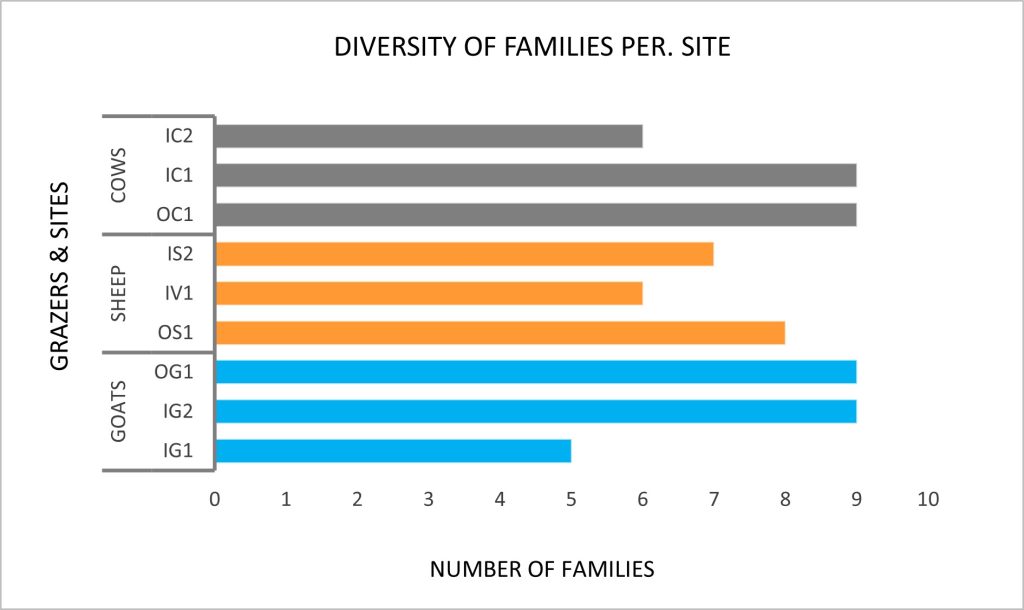


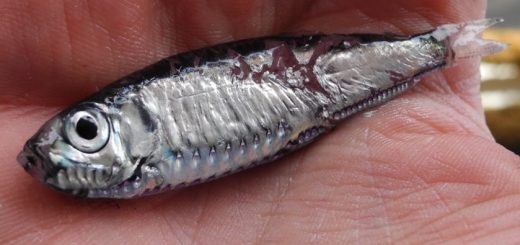
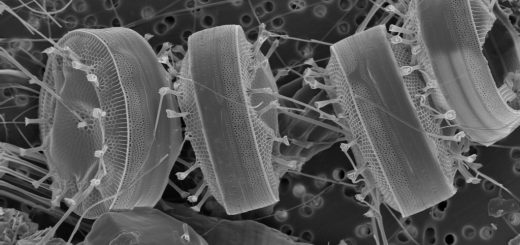
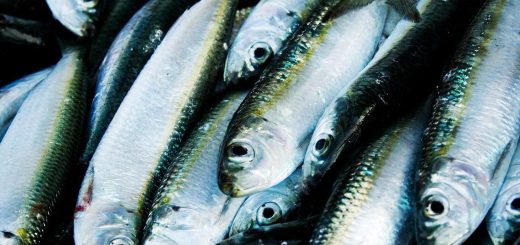
1 Response
[…] I. (2023). The beetles and the beasts. Bikuben […]